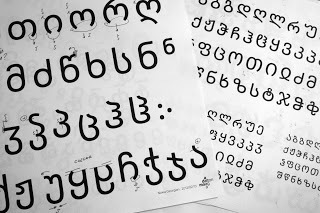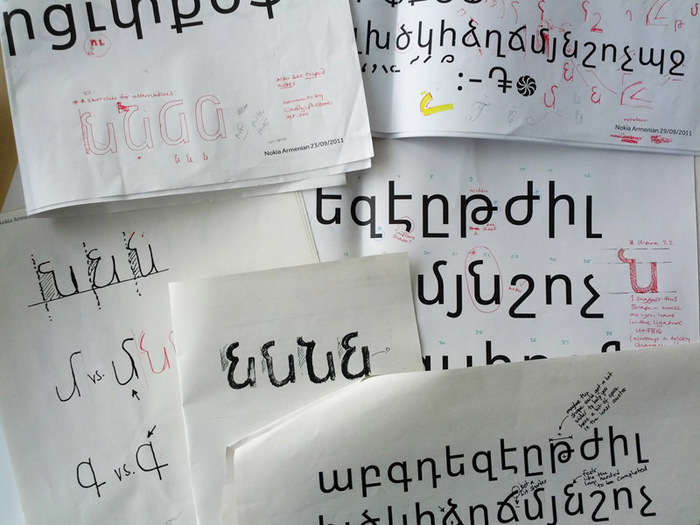
Gorgeous #Georgian for #Nokia #Pure http://nokiapureblog.daltonmaag.com/2012/05/gorgeous-georgian-for-nokia-pure.html The Georgian #alphabet differs considerably from the #Latin alphabet. Latin #typefaces have an x-height, which is, as the name suggests, the area in a typeface that is the height of a lowercase x. This is the area in which most of the visual information is concentrated, and that makes the #letters readable. In #Nokia-Pure we have purposefully enlarged the x-height to aid readability. In Georgian there is no equivalent of an x-height; it is the middle portion of the letter that has most of the visual information. We had to create entirely different #proportions to deal with this #script, but maintain the look and feel of the Latin #font.
#նախագիծ #տառատեսակ #վրացերեն #georgia

#nokia #pure : Answering the Challenge of #Armenian http://nokiapureblog.daltonmaag.com/2012/06/answering-challenge-of-armenian.html
The nature of the script brings interesting challenges for designers. A strong feature of the script is the frequent repetition in the uppercase and lowercase of shapes like the u, o, n, and m. These shapes create quite a rigid texture, so spacing and the right proportions are crucial for the design of the Armenian.
#design #font #տառատեսակ #դիզայն #նախագծում #նոկիա #հայերեն
This is already an old #tradition, that #OSCE #observers acknowledge #faked #elections as #pure, #transparent and #democratic.
http://www.youtube.com/watch?v=wezm_DRkozs
The OSCE observers walked out of the hall when Nazaryan took the podium to read the statement on behalf of the citizens of #Armenia.
Dear political tourists, we have had enough of your efforts to legitimize the #fraudulent elections.
The recent presidential election in Armenia, when compared to previous presidential elections, has registered one step forward and three steps backwards, two steps to the right and a half step to the left. In a word, they haven’t corresponded to the RA Constitution, to the demands of the Election Code as well as international standards.
The elections have proceeded against the backdrop of proposed reforms to the Election Code by the parliamentary opposition that were rejected by the ruling majority. Even though international and domestic observers, rights defenders and the opposition raised concerns, especially regarding glaring inaccuracies in the voter rolls, after the parliamentary election, nevertheless, the ruling authorities did nothing to fix the problem before this recent presidential election.
In essence, last year’s parliamentary election and yesterday;’ presidential election took place on the same legal-normative basis.
Of note is the fact that in the February 18 presidential election none of Armenia’s primary political opposition forces either nominated their own candidate or supported any of the nominated candidates. I refer to the Armenian National Congress, Prosperous Armenia, the AR and the Free Democrats. This is ample proof that the election was not truly competitive.
The fact that none of the primary opposition groups refused to nominate their own candidate or support any other candidate running, points to the deep level of mistrust of citizens and political forces regarding the electoral process.
Thus, the opposition forces in the parliament, from the outset, have labelled the presidential election as a farce and a show, since as previously noted, the ruling majority squashed the passage of election reforms proposed by the opposition prior to the election period.
Even though on the surface there was the appearance that important democratic freedoms were being safeguarded during the campaign, including the right to run a free campaign, in reality, the campaign was noteworthy by its competitive inequality in favour of the candidate of the regime. In particular, administrative resources and powers were put into the service of the latter. This was accomplished via pressure brought to bear on state and public employees to attend campaign events of Serzh Sargsyan and to vote in his favour.
The election campaign did not proceed peacefully. Violence was inflicted on candidate Paryur Hayrikian. The man was shot. Another candidate, Andreas Ghoukasyan, staged a hunger strike to protest the electoral process which he labelled a mere show. The press covered cases of violence even on Election Day.
The campaign also stood out by its lack of political and individual professionalism. Candidates employed the crudest of language and public relation stunts. For example, the various incidents that took place during the campaign conducted by the regime’s candidate were widely mocked by large segments of society. As a consequence, citizens tended not to take the election process seriously.
On Election Day, polling precincts were transformed into theatrical stages where citizens showed their attitude to the process. The press and social internet sites were full of ballots invalidated by voters who drew caricatures on them. They drew images of figures from the plant and animal world, images lifted from fairy tales and television cartoon characters. In one precinct, a voter literally ate his ballot as a sign of protest. It significant to note that according to official statistics, the number of invalidated ballots came in third place.
Reports of duplicate voting, ballot stuffing, bribes, and substitute voting and other scams were raised throughout the election itself.
Thus, yesterday’s presidential election in Armenia can be described as yet another normal appalling election.
Dear political tourists, we’ve had enough of you legitimizing the fraudulent election. You are trampling those democratic values that you yourselves have broken.